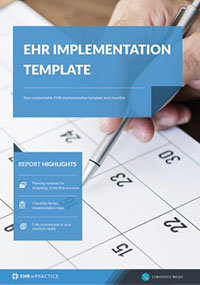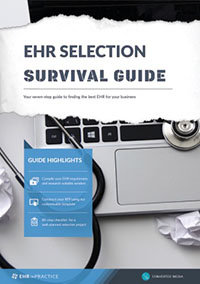5 important areas of EHR training during implementation
Having gone through the requirements gathering, budgeting, and selection process, the time has come to focus on implementation. A crucial element of which is the EHR training for all users of the system. However, training is not simply just a matter of conveying information to users; it must be conducted in a manner that takes into account an organization’s needs and strategic goals, the competency level and learning styles of trainees, as well as any other practical considerations that assist or present barriers to training. In sum, implementation and post-implementation training should be part of an organization’s overall technology strategy since an EHR’s value to a healthcare practice depends largely on its user’s ability to make the most of the technology. Even when armed with the most sophisticated EHR, an organization that is unable to train its EHR users effectively is wasting valuable technology resources by not giving users the skills to optimally use the EHR.
The following provides a discussion of the benefits of effective EHR training and five key areas of focus for EHR training.
Why is EHR training important?
Training staff for EHR is associated with a number of benefits beyond simply acquiring technical competency on an EHR system. For example, research indicates that training can positively influence providers’ willingness to use EHRs effectively, and their understanding of how the system can be leveraged to improve clinical practice through the use of advanced features. Lastly, with better training, providers are more likely to be satisfied with healthcare information technology.
However, proper training is often treated as an afterthought to implementation planners, and typically organizations disregard EHR training to their own detriment. As noted in the journal, Applied Clinical Information, user training is often not treated as essential to the implementation process and thus frequently suffers from minimal institutional investment. Other research on this topic indicates the result from this institutional neglect is that clinical users often rate their organization’s training as lacking. According to survey data taken from clinical EHR users, 43% of clinician users rated their initial EHR training as “less than adequate,” while 94.6% of respondents thought their ability to use the EMR could be improved. With the perils of neglecting training in mind, what can be done to improve EHR training?
Use our free EHR implementation template to plan your EHR project
1. Create an EHR training timeline based on goals
As a preliminary note, EHR training is an ongoing process that should extend beyond the initial implementation phase. Therefore, one should not assume that the training timeline should end on the go live date. As systems update new features may be added requiring users to be trained on these updates. Further, as will be discussed below, training should be designed to give users the skills to improve their EHR competency beyond just basic skills, rather the goal should be to provide continuing enrichment opportunities for users to make the most out of their organization’s EHR. As such, healthcare organizations should establish a training timeline with milestones that are tied to goals involving users and how they should be using the EHR.
For example, when creating a training timeline, for which you will set short and long-term goals for training completion; a short-term goal would be to have all users learn to log-in to the system (and ensure access) by week one, whereas a long-term goal would be to train all patient care coordinators to input a new patient by week four. Plan to have multiple training sessions and set aside time in schedule for training. By allowing dedicated time for training, you will achieve greater concentration from the staff.
2. Assess training needs and user’s skill levels
It is important to properly assess your clinicians’ current skill level and comfort with computers, especially for those that are transitioning from paper charts. Determine if your staff are computer-literate or if they need additional training. If your budget allows, seek out additional basic computer training for those clinicians who have less practical understanding of technology. Given time, even the most reluctant or technology-averse users can become well-informed users of an EHR system if allowed to develop their skills under a training plan that allows them to progress.
Armed with information concerning users’ skill levels and needs, training should be based only on what each department or clinician needs to know. Trying to train the entire staff on all aspects of the new EHR system is a waste of time and resources. If an evaluating physical therapist needs to know how to document initial evaluation findings and a physical therapist assistant only needs to know how to write a daily note, then save time by only including the physical therapist in the evaluation documentation training. Too often, practices make the mistake of training staff in areas that they won’t need to use in the foreseeable future. By focusing training on the “need to know” areas, there will be less confusion and greater attention paid to the training session. The U.S. Department of Health and Human Services advises using duty specific training for general staff and create more specific training module for EHR specialists.
3. EHR training team
A training team should be a representative sample of your practice with all stakeholders involved. For example, administrative staff, clinical staff, and any other parties that can bring insight to the team regarding training needs and effective methods of assisting users learn. Among this team super users (or peer experts) should be designated to offer on the ground information to users and to provide further formal and informal training if needed.
As such, it is important to designate an individual in each department that has a more comprehensive understanding of the system. This person will likely have a good practical understanding of tech and will be provided additional training. This way, your clinical staff members will have someone to reach out to in their own respective departments. Identify leaders in your practice who will be called upon to mentor and train inexperienced staff.
4. Use real time and hands on EHR training
Allow staff to follow along with training in real time. Each staff member should be seated with a computer to follow along with the instructing super user. Provide each clinician a “cheat sheet” or reference page as well. All instructions should be written out for later reference. By providing all instruction on a written reference page, clinicians will be able to follow along and “do” instead of “watch.” By inputting data and selecting patient records along with the instructor, they will better remember their training. Watching is too passive. Encourage action.
When it comes to EHR training; utilize the resources that your EHR system provides. Training does not stop with one, two or even ten training sessions. Select a good EHR vendor and they will make themselves available to your users for further reference and questions even after implementation.
5. Choosing the right curriculum
Curriculum selection is simply a matter of looking at organizational goals regarding EHR use and addressing areas in which users are deficient that could prevent EHR-related goals from being attained.
Information gathering occupies an important part in curriculum design. For example, researchers at Kaiser Permanente, Mid-Atlantic States (KPMAS) conducted a study of EHR effectiveness training. The researchers indicated that the foundation of targeted EHR training is based on using a number of sources of information on which to design course content, these sources include:
(a) widespread support questions,
(b) operational efficiency training content from health care community,
(c) recently added EHR enhancements, and
(d) survey data from expert users.
Much like the discussion above, regarding targeted training, a training curriculum should be built on areas of need based on information collected from the sources mentioned above. With information collected from the listed sources, a training curriculum can be designed that addresses key areas in which users are deficient.
Check out our free EHR implementation plan and use our step-by-step checklist
EHR Training Checklist
When designing an EHR training program ensure that you include each step listed below in your plan:
- Assemble a training team using key stakeholders
- Assess the amount of support the vendor will provide for training during implementation and after
- Collect data regarding training needs
- Establish training goals
- Create a training plan
- Create a training timeline
- Identify superusers
- Identify the training methods such as the method of delivery and style of instruction
- Establish training schedules, location, and staffing
- Refine and adjust the training program based on feedback
- Establish post-implementation training objectives
Without proper training, the EHR system will not be used to its fullest capacity. By making training an ongoing process, users can optimize their EHR use, making the most of its features and become more engaged in a practice’s mission, thus avoiding setbacks and errors, reducing employee frustration and decreasing employee turnover.
Originally written by: Amy Vant
Free white paper

EHR implementation: 6 steps to success
Step-by-step information on how to implement EHR effectively

Free white paper

EHR Implementation Template
Get all the planning tools you need to make your EHR implementation a success

Featured white papers
Related articles
-

EHR Implementation Plan: Your 8-Step Checklist
Your comprehensive checklist for creating an EHR implementation plan.
-

A template for your EHR project implementation timeline
Determining your EHR project timeline will prove tricky, but having some expectations of time fra...
-

5 key stakeholders in your EHR selection
Learn about the individuals that, when consulted early and often, can make your EHR selection pro...



